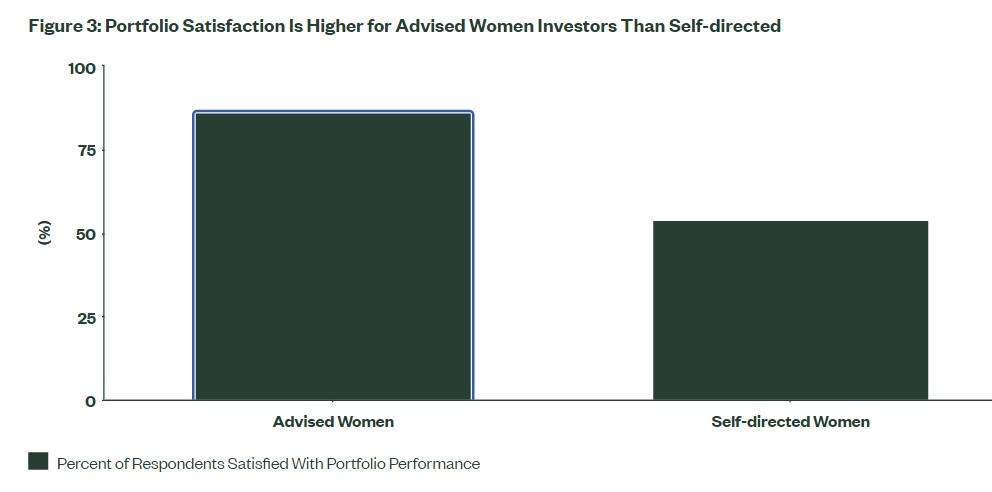By: Brie Williams ,Head of Practice Management
There are fundamental similarities in how all types of investors approach their financial lives — but women often take different life journeys. And the financial circumstances and decisions they face along the way can impact their investing goals, their investment decision making, and even the perceived value of financial advice itself.
A Gender Wealth Gap — and an Advisory Gap
The wage to wealth gap between women and men has been widely documented. But did you know that a 10% gender pay gap can lead to a whopping 40% gender wealth gap?1 It’s no wonder women are more likely to perceive gaps in meeting their financial goals.2 They’re often balancing their goals with time out of the workforce, lower lifetime earnings, and a potentially longer life span. A global wealth equity study found that women are likely to reach retirement with just 74% of the wealth accumulated by men; pay gaps and delayed career progress are the primary drivers.3
Women Manage Assets but Are Underserved by Financial Advisors
It’s estimated that women contribute $7 trillion to US GDP per year4 and control a third of total US household financial assets. That’s more than $10 trillion.5 They’re also the primary breadwinners for nearly 30% of married households and nearly 40% of total US households.6
Despite these remarkable strides in economic power, and with so much money to influence, Gen X women feel vastly underserved.
Figure 1: Women Investors Across the Globe (Australia, UK, and US)

Generation X Women: Empowered — and Exhausted
Born between 1965 and 1980, the Gen X cohort overall was raised to believe that women could do anything. They could have it all. Many Gen X women were often the first in their families to go to college, to live on their own, launch a career, or opt to stay home to raise their children.
Now, running through or leaving their 40s behind, Gen X women are grappling with new challenges as the first workforce generation to be caregivers to both children and senior parents.7 In an effort to have it all, they paved the way for concepts like work/life balance. But they also report high levels of work/family interference — and are exhausted by it.8
Meanwhile, they’re in the midst of their peak earning years and are resilient in their ambition to move ahead financially. Fifty-nine percent of Gen X women say they fully take the lead in financial decisions.9 Yet they also report being especially underserved, with less than half saying they work with a financial advisor, as seen in Figure 1.
Gen X Women and the Advisory Opportunity
The 55% of Gen X women who do not currently work with an advisor present a clear and compelling growth opportunity. Research suggests wealth management firms that can attract, grow, and retain high-growth clients segments — including Gen X and millennial women — could see up to four times faster revenue growth.10
The data is positive for women investors too. Survey results show that having a financial advisor, versus self-directed investing, has a significantly positive impact on a woman’s financial optimism (Figure 2). And 90% of advised women investors said they value their financial advisors’ knowledge and guidance even more in uncertain times.
Figure 2: Optimism Is Higher for Advised Women Investors Than Self-directed

Advisors who take the time to understand the balancing act many Gen X women investors face should be well-positioned to create comprehensive plans that account for women investors’ goals and priorities, as well as their unique risks.
The bottom line is this: under advised Gen X women investors present advisors with opportunity — the potential to grow their business while playing a vital role in helping to close the gender wealth gap. If you ask me, that sounds like a win-win for advisors and Gen X women investors alike.
This post first appeared on August 16th, 2023 on the State Street Global Advisors’ blog
PHOTO CREDIT: https://www.shutterstock.com/g/ntkris
Via SHUTTERSTOCK
Footnotes
1 UBS, Women’s Wealth 2030.
2 McKinsey & Company, Women as the next wave of growth in US wealth management, July 2020.
3 WTW, 2022 Global Gender Wealth Equity Report, November 2022.
4 Kate Bahn and Annie McGrew, A Day in the US Economy Without Women, Center for American Progress, March 2017.
5 McKinsey & Company, Women as the next wave of growth in US wealth management, July 2020.
6 Bureau of Labor Statistics, 2018.
7 Lis Rabasca Roepe, “Are Gen X Women Being Squeezed Out of the Workplace?,” FastCompany.com, December 14, 2015.
8 Ada Calhoun, “The New Midlife Crisis – Why (and How) It’s Hitting Gen X Women,” Oprah.com, October 2017.
9 Boston Consulting Group Global Investor Survey, 2020.
10 Analysis by McKinsey & Company’s PriceMetrix, Women as the next wave of growth in US wealth management, July 2020.
Disclosure
The whole or any part of this work may not be reproduced, copied or transmitted or any of its contents disclosed to third parties without SSGA’s express written consent.
The views expressed in this material are the views of the State Street Global Advisors Practice Management Group through the period ended August 15, 2023 and are subject to change based on market and other conditions. The opinions expressed may differ from those with different investment philosophies. The information provided does not constitute investment advice and it should not be relied on as such. It does not take into account any investor’s particular investment objectives, strategies, tax status or investment horizon.
This document contains certain statements that may be deemed forward-looking statements. Please note that any such statements are not guarantees of any future performance and actual results or developments may differ materially from those projected.



